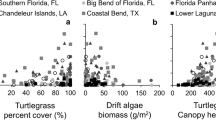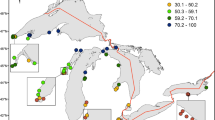Abstract
Shallow freshwater aquatic ecosystems are discrete feeding patches for fish eating birds. A unique feature of these ecosystems is that their physical conditions can change dramatically in a short period of time, particularly temperature, turbidity, and dissolved oxygen. Based on previous research we predicted that increasing turbidity will reduce the availability of fish to birds due to reduced visibility, while increasing temperature and decreasing dissolved oxygen will increase their availability through increases in activity and movement towards the more oxygenated surface areas, respectively. We also predicted that overall abundance of fish should increase feeding activity by terns. We measured these environmental variables, bird activity, and fish abundance from May to August from 2006 to 2008 in a marsh in southern Manitoba, Canada. Our results showed that only variation in dissolved oxygen levels affected feeding activity by terns. Since there was no relationship between bird and fish abundance either within or among years, these results suggest that it is the availability of prey (i.e. the upward movement of fish into the water column) and not their abundance per se that influences the number of avian predators present and hence the risk of predation to fish. These data demonstrate how the physical environment of aquatic ecosystems can impact terrestrial avian predators, and the link that exists between the physical environment and predator-prey interactions.




Similar content being viewed by others
References
Abrahams MV, Mangel M, Hedges K (2007) Predator-prey interactions and changing environments: who benefits? Phil Trans R Soc 362:2095–2104
Ainley DG (1977) Feeding methods in seabirds: a comparison of polar and tropical nesting communities in the eastern Pacific Ocean. In: Llano GA (ed) Adaptations within Antarctic ecosystems. Smithsonian Institute, Washington, D.C., pp 669–685
Allouche S, Gaudin P (2001) Effects of avian predation threat, water flow and cover on growth and habitat use by chub, Leuciscus cephalus, in an experimental stream. Oikos 94:481–492
Anderson MT, Kiesecker JM, Chivers DP, Blaustein AR (2001) The direct and indirect effects of temperature on a predator-prey relationship. Can J Zool 79:1834–1841
Atkinson D (1994) Temperature and organism size: a biological law for ectotherms? Adv Ecol Res 25:1–58
Bluso-Demers J, Colwell MA, Takekawa JY, Ackerman JT (2008) Space use by Forster’s Terns breeding in south San Francisco Bay. Waterbirds 31:357–364
Clarke A, Johnston NM (1999) Scaling of metabolic rate with body mass and temperature in teleost fish. Ecology 68:893–905
Collis K, Roby DD, Craig DP, Ryan BA, Ledgerwood RD (2001) Colonial waterbird predation on juvenile salmonids tagged with passive integrated transponders in the Columbia River Estuary: vulnerability of different salmonid species, stocks, and rearing types. Trans Am Fish Soc 130:385–396
Crowder LB, Cooper WE (1982) Habitat structural complexity and the interaction between bluegills and their prey. Ecology 63:1802–1813
Eklöv P, Persson L (1996) The response of prey to the risk of predation: proximate cues for refuging juvenile fish. Anim Behav 51:105–115
Fraser G (1997) Feeding ecology of Forster’s terns on Lake Osakis. Minnesota Col Waterbirds 20:87–94
Godin J-GJ, Crossman SL (1994) Hunger-dependent predator inspection and foraging behaviours in the threespine stickleback (Gasterosteus aculeatus) under predation risk. Behav Ecol Sociobiol 34:359–366
Harvey BC, Stewart AJ (1991) Fish size and habitat depth relationships in headwater streams. Oecologia 87:336–342
He X, Kitchell JF (1990) Direct and indirect effects of predation on a fish community: a whole-lake experiment. Trans Am Fish Soc 119:825–835
Hodgens LS, Blumenshine SC, Bednarz JC (2004) Great blue heron predation on stocked rainbow trout in an Arkansas tailwater fishery. N Am J Fish Man 24:63–75
Kramer DL (1987) Dissolved oxygen and fish behaviour. Env Biol Fishes 2:81–92
Kramer DL, Manley D, Bourgeois R (1983) The effect of respiratory mode and oxygen concentration on the risk of aerial predation in fishes. Can J Zool 61:653–665
Krause J, Godin J-GJ (1995) Predator preference for attacking particular prey group sizes: consequences for predator hunting success and prey predation risk. Anim Behav 50:465–473
Lass S, Spaak P (2003) Temperature effects on chemical signaling in a predator-prey system. Fresh Biol 48:669–677
Milinski M, Heller R (1978) Influence of a predator on the optimal foraging behaviour of sticklebacks (Gasterosteus aculeatus L.) Nature 275:642–644
Mittelbach GG, Chesson PL (1987) Predation risk: indirect effects on fish populations. In: Kerfoot WC, Sih A (eds) Predation: direct and indirect impacts on aquatic communities. University Press of New England, Hanover and London, pp 537–555
Moore MK, Townsend VR Jr (1998) The interaction of temperature, dissolved oxygen and predation pressure in an aquatic predator-prey system. Oikos 81:329–336
Nestlerode JA, Diaz RJ (1998) Effects of periodic environmental hypoxia on predation of a tethered polychaete, Glycera Americana: implications for trophic dynamics. Mar Ecol Prog Series 172:185–195
Pihl L, Baden SP, Diaz R, Schaffner L (1992) Hypoxia induced structural changes in the diet of bottom feeding fish and Crustacea. Mar Biol 112:349–361
Pink M, Abrahams MV (2016) Temperature and its impact on predation risk within aquatic ecosystems. Can J Fish Aquat Sci 73:869–876
Randle AM, Chapman LJ (2004) Habitat use by the African anabantid fish Ctenopoma muriei: implications for costs of air breathing. Ecol Freshwater Fish 13:37–45
Robb T, Abrahams MV (2003) Variation in tolerance to hypoxia in a predator and prey species: an ecological advantage of being small? J Fish Biol 62:1067–1081
Salt GW, Willard DE (1971) The hunting behavior and success of Forster's tern. Ecology 52:989–998
Steinmetz J, Soluk DA, Kohler SL (2008) Facilitation between herons and smallmouth bass foraging on common prey. Env Biol Fishes 81:51–61
Strod T, Izhaki I, Arad Z, Katzir G (2008) Prey detection by great cormorant (Phalacrocorax carbo sinensis) in clear and in turbid water. J Exp Biol 211:866–872
Suthers IM, Gee JH (1986) Role of hypoxia in limiting diel spring and summer distributions of juvenile yellow perch (Perca flavescens) in a prairie marsh. Can J Fish Aquat Sci 43:1562–1570
Taylor DL, Collie JS (2003) A temperature- and size- dependent model of sand shrimp (Crangon septemspinosa) predation on juvenile winter flounder (Pseudopleuronectes americanus). Can J Fish Aquat Sci 60:1133–1148
Tonn WM, Magnuson JJ (1982) Patterns in the species composition and richness of fish assemblages in northern Wisconsin lakes. Ecology 63:1149–1166
Turner AM, Mittelbach GG (1990) Predator avoidance and community structure: interactions among piscivores, planktivores and plankton. Ecology 71:2241–2254
Wanzenbock J, Mikheev VN, Pasternak AF (2006) Modification of 0+ perch foraging behaviour by indirect cues of predation risk. Ecol Freshwater Fish 15:118–124
Weetman D, Atkinson D, Chubb JC (1998) Effects of temperature on anti-predator behaviour in the guppy, Poecilia reticulta. Anim Behav 55:1361–1372
Weetman D, Atkinson D, Chubb JC (1999) Water temperature influences the shoaling decisions of guppies, Poecilia reticulata, under predation threat. Anim Behav 58:734–741
Werner EE, Anholt BR (1996) Predator-induced behavioral indirect effects: consequences to competitive interactions in anuran larvae. Ecology 77:157–169
Werner EE, Gilliam JF (1984) The ontogenetic niche and species interactions in a size-structured populations. Ann Rev Ecol Syst 15:393–425
Werner EE, Gilliam JF, Hall DJ, Mittelbach GG (1983) An experimental test of the effects of predation risk on habitat use in fish. Ecology 64:1540–1548
Whitfield AK, Blaber SJM (1978) Feeding ecology of piscivorous birds at Lake St. Lucia, Part I: Diving birds. Ostrich 49:185–198
Wolf NG, Kramer DL (1987) Use of cover and the need to breath: the effects of hypoxia on vulnerability of dwarf gouramis to predatory snakeheads. Oecologia 73:127–132
Acknowledgements
Funding for this research was provided by research grants to MA from NSERC and an internal grant from the University of Manitoba. MP was supported by an NSERG postgraduate scholarship. We are grateful to the assistance provided by the staff of the University of Manitoba’s Field Station at Delta Marsh.
Author information
Authors and Affiliations
Corresponding author
Ethics declarations
Ethics
The research described in this manuscript was reviewed by the University of Manitoba’s Animal Care Committee and determined to conform to the ethical requirements of the Canadian Council on Animal Care (Protocol Number F03–041/1/2/3).
Rights and permissions
About this article
Cite this article
Pink, M., Abrahams, M.V. In shallow water ecosytems the abiotic environment is more important than prey abundance for foraging terns. Environ Biol Fish 101, 355–362 (2018). https://doi.org/10.1007/s10641-017-0644-8
Received:
Accepted:
Published:
Issue Date:
DOI: https://doi.org/10.1007/s10641-017-0644-8




